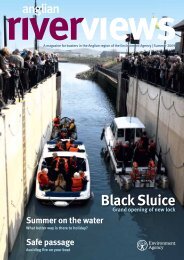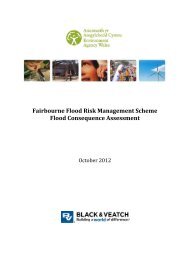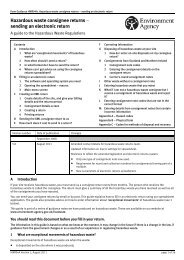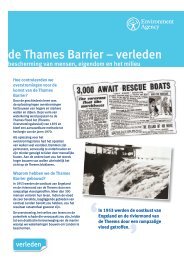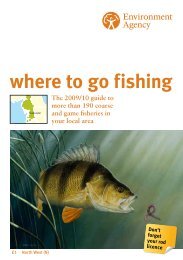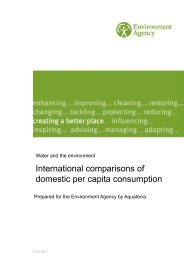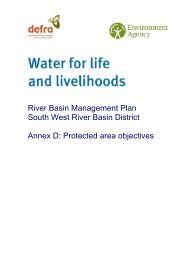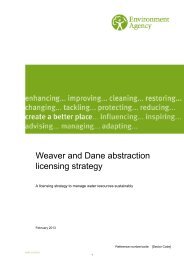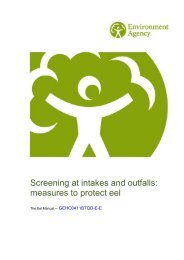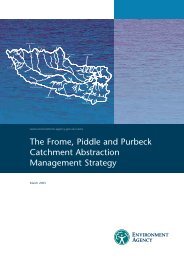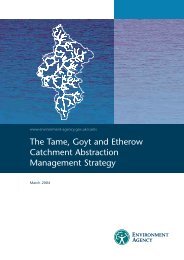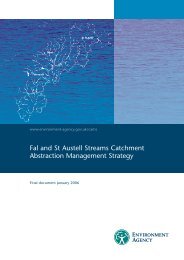Karenia mikimotoi
Karenia mikimotoi
Karenia mikimotoi
Create successful ePaper yourself
Turn your PDF publications into a flip-book with our unique Google optimized e-Paper software.
This report does, however, highlight the potential need for vigilance in monitoring<br />
reports of the unusual occurrence of dead fish on beaches, or reported incidents of skin<br />
irritation and/or lesions in water users in eutrophic estuaries in the UK as these would<br />
probably be the first indications of any harmful effects due to Pfiesteria spp.<br />
3.5.5 Monitoring strategies<br />
Because of the possible health implications and economic impact on coastal areas in<br />
several US states, there is a considerable amount of information available on<br />
monitoring strategies. For example, the US Centers for Disease Control and Prevention<br />
(CDC) organised a conference on the theme ‘Pfiesteria: From Biology to Public Health’<br />
(see Anon., 2001b).<br />
Protocols for monitoring Pfiesteria and related fish health and environmental conditions<br />
in US Coastal Waters (Turgeon et al., 2001) deal specifically with fish kills, but these<br />
would be among the first signs of harmful effects due to the dinoflagellate. The<br />
proceedings of the National Oceanographic and Atmospheric Agency workshops to<br />
standardize protocols for monitoring toxic Pfiesteria species and associated<br />
environmental conditions were reported by Luttenberg et al. (2001). A brief summary of<br />
monitoring for Pfiesteria-like organisms in coastal waters is given in Anderson et al.<br />
(2001).<br />
As regards public information, a good is example the State of Maryland Department of<br />
Natural Resources website, which has a page entitled ‘What you should know about<br />
Pfiesteria’ - http://www.dnr.state.md.us/bay/cblife/algae/dino/pfiesteria/facts.html ,<br />
which provides very comprehensive information. It includes this advice:<br />
Is it safe to swim and boat in coastal waters?<br />
• Swimming, boating, and other recreational activities in coastal waters are<br />
generally safe. To be on the safe side, the following common-sense<br />
precautions are recommended:<br />
• Comply with state closures of water bodies and public health advisories. Do<br />
not go into or near the water in areas that are closed by the state.<br />
• If you notice significant numbers of fish that are dead or that exhibit lesions<br />
or other signs of disease, avoid contact with the fish and water, and<br />
promptly report the incident to your state's environment or natural resource<br />
agency.<br />
3.6 Chrysochromulina polylepis<br />
The toxic haptophyte C. polylepis is found in the waters around Norway, Sweden and<br />
Denmark, and also in the Irish Sea. It first attracted attention following a massive bloom<br />
in Norway in 1988, which resulted in extensive mortalities to fish, invertebrates and<br />
other aquatic organisms (Landsberg, 2002; Smayda, 2006). Its toxic properties have<br />
been reviewed by Landsberg (2002). It produces haemolysins, which have been<br />
identified as mono-galactosyl diacylglycerol and octadecapentaenoic acid (18:5n-3).<br />
The Chrysochromulina polylepis toxin appears to interfere with cell membrane<br />
functions and ionic balance (Underdal et al., 1989; Meldahl et al., 1993 cited in<br />
Landsberg, 2002). Because of this nonspecific effect C. polylepis affects a wide range<br />
of aquatic organisms from protists to fish (Edvardsen and Paasche, 1998, cited in<br />
Landsberg, 2002). On the basis of evidence of toxic compounds extracted from<br />
mussels affected by a bloom of C. polylepis it has been suggested that the alga may<br />
produce a group of ichthyotoxins similar to those of Prymnesium parvum (Stabell et al.,<br />
1993).<br />
20 A Literature review of the potential health effects of marine microalgae and macroalgae



